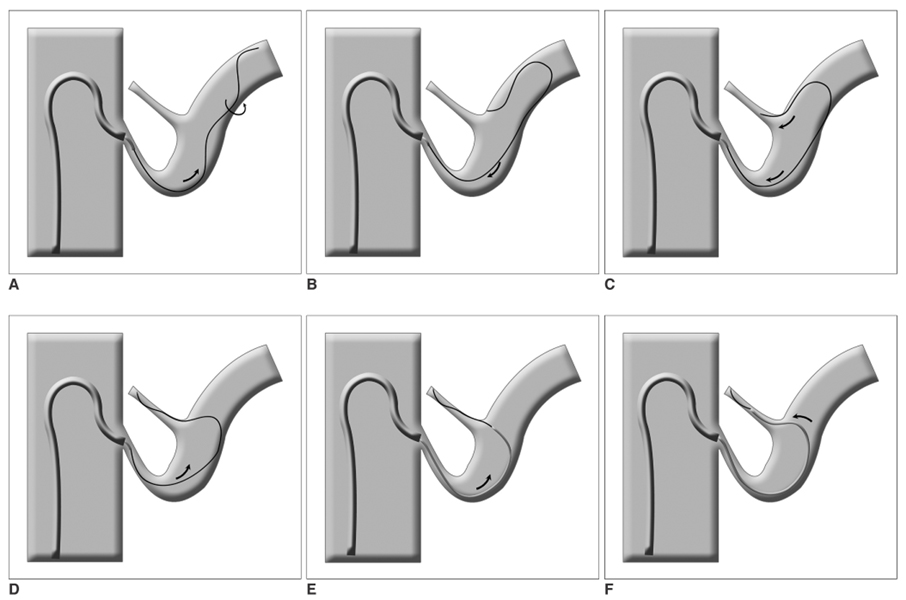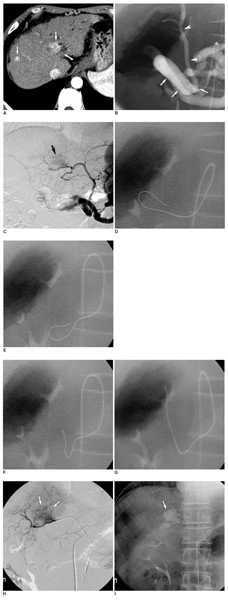Korean J Radiol.
2007 Jun;8(3):225-230. 10.3348/kjr.2007.8.3.225.
A New Technique for Superselective Catheterization of Arteries: Preshaping of a Micro-Guide Wire into a Shepherd's Hook Form
- Affiliations
-
- 1Department of Radiology, Seoul National University College of Medicine, Institute of Radiation Medicine, Seoul National University Medical Research Center and Clinical Research Institute, Seoul National University Hospital, Seoul, Korea. 100paper@radiol.s
- KMID: 1779438
- DOI: http://doi.org/10.3348/kjr.2007.8.3.225
Abstract
OBJECTIVE
We wanted to introduce a new technique for superselective catheterization of arteries with preshaping of a micro-guide wire into a shepherd's hook form, and this is useful for superselection of small arteries branching at an acute angle from a large parent artery for the treatment of tumors and hemorrhages. MATERIALS AND METHODS: We developed a superselective catheterization technique by using preshaping of a micro-guide wire into a shepherd's hook form. We encountered six patients in our practice for whom we failed to catheterize the small tumor-feeding arteries that branched at an acute angle from wide parent arteries during chemoembolization of hepatocellular carcinoma; the parent arteries were the right inferior phrenic artery (n = 4) and the left gastric artery (n = 1) from the celiac axis with celiac stenosis due to compression by the median arcuate ligament and the proper hepatic artery from the gastroduodenal artery (n = 1) in a patient who had celiac axis occlusion with collateral circulation via the pancreaticoduodenal arcade from the superior mesenteric artery. In these consecutive six patients, we tested the usefulness of this new technique with employing preshaping of a micro-guide wire into a shepherd's hook form for superselective catheterization of targeted vessels. RESULTS: The target arteries were successfully catheterized and satisfactory transcatheter arterial chemoembolization was performed in all six patients. There were no significant complications such as arterial dissection. CONCLUSION: We developed a technique that is effective for superselection of vessels with preshaping of micro-guide wire into a shepherd's hook form, and we successfully applied it during chemoembolization of hepatocellular carcinoma. This technique can be useful for superselection of small arteries that branch from a large parent artery at acute angles for the treatment of tumors and hemorrhages.
Keyword
MeSH Terms
Figure
Reference
-
1. Chung JW, Park JH, Han JK, Choi BI, Han MC, Lee HS, et al. Hepatic tumors: predisposing factors for complications of transcatheter oily chemoembolization. Radiology. 1996. 198:33–40.2. Chung JW, Park JH, Han JK, Choi BI, Kim TK, Han MC. Transcatheter oily chemoembolization of the inferior phrenic artery in hepatocellular carcinoma: the safety and potential therapeutic role. J Vasc Interv Radiol. 1998. 9:495–500.3. Song SY, Chung JW, Kwon JW, Joh JH, Shin SJ, Kim HB, et al. Collateral pathways in patients with celiac axis stenosis: angiographic-spiral CT correlation. Radiographics. 2002. 22:881–893.4. Gokan T, Hashimoto T, Matsui S, Kushihashi T, Nobusawa H, Munechika H. Helical CT demonstration of dilated right inferior phrenic arteries as extrahepatic collateral arteries of hepatocellular carcinomas. J Comput Assist Tomogr. 2001. 25:68–73.5. Park CM, Chung JW, Kim HB, Shin SJ, Park JH. Celiac axis stenosis: incidence and etiologies in asymptomatic individuals. Korean J Radiol. 2001. 2:8–13.6. Miyayama S, Matsui O, Akakura Y, Yamamoto T, Fujinaga Y, Koda W, et al. Use of a catheter with a large side hole for selective catheterization of the inferior phrenic artery. J Vasc Interv Radiol. 2001. 12:497–499.7. Won JH, Park SI, Park KJ, Oh YJ, Hwang SC. Microcatheter placement through a side hole created in a 5-F catheter into proximal subclavian arterial branches causing hemoptysis. J Vasc Interv Radiol. 2004. 15:881–884.8. Kwon JW, Chung JW, Song SY, Lim HG, Myung JS, Choi YH, et al. Transcatheter arterial chemoembolization for hepatocellular carcinomas in patients with celiac axis occlusion. J Vasc Interv Radiol. 2002. 13:689–694.9. Kiyosue H, Matsumoto S, Hori Y, Okahara M, Sagara Y, Mori H. Turn-back technique with use of a shaped microcatheter for superselective catheterization of arteries originating at acute angles. J Vasc Interv Radiol. 2004. 15:641–643.
- Full Text Links
- Actions
-
Cited
- CITED
-
- Close
- Share
- Similar articles
-
- A Broken J-Guide Wire during Central Venous Catheterization : A case report
- Accidental Insertion of Entire Guide - Wire in the Inferior Vena Cava During Central Venous Catheterization
- Three-dimensional finite element analysis of initial tooth displacement according to force application point during maxillary six anterior teeth retraction using skeletal anchorage
- Angioplasty at Coronary Bifurcation
- Guide Wire Entrapment during Central Venous Catheterization



